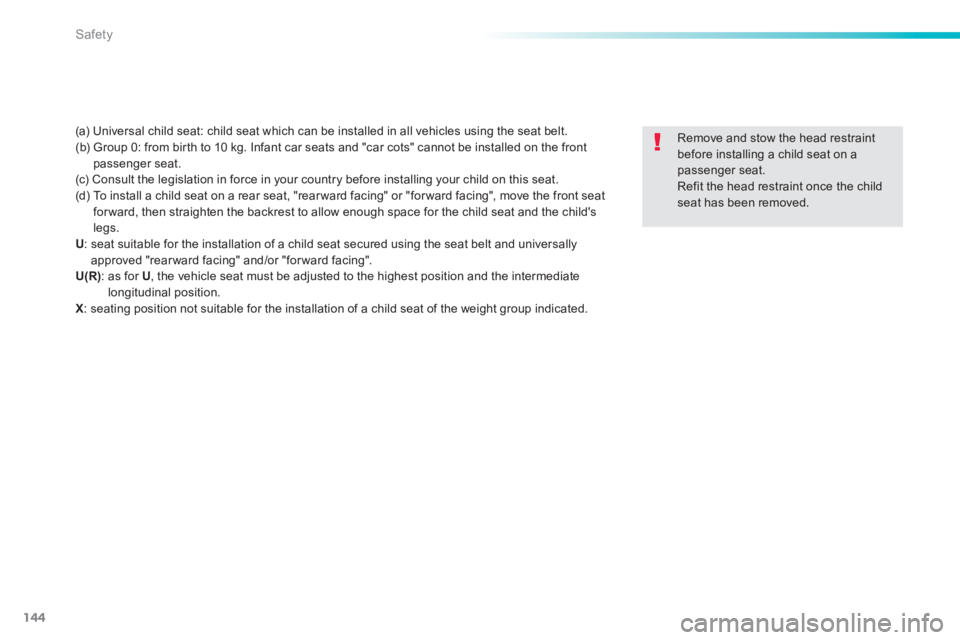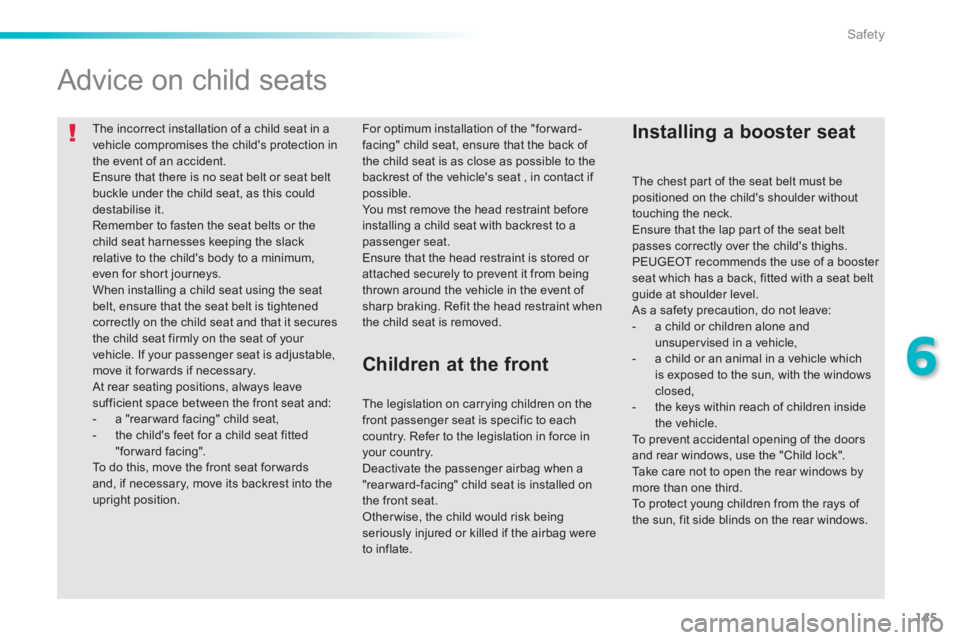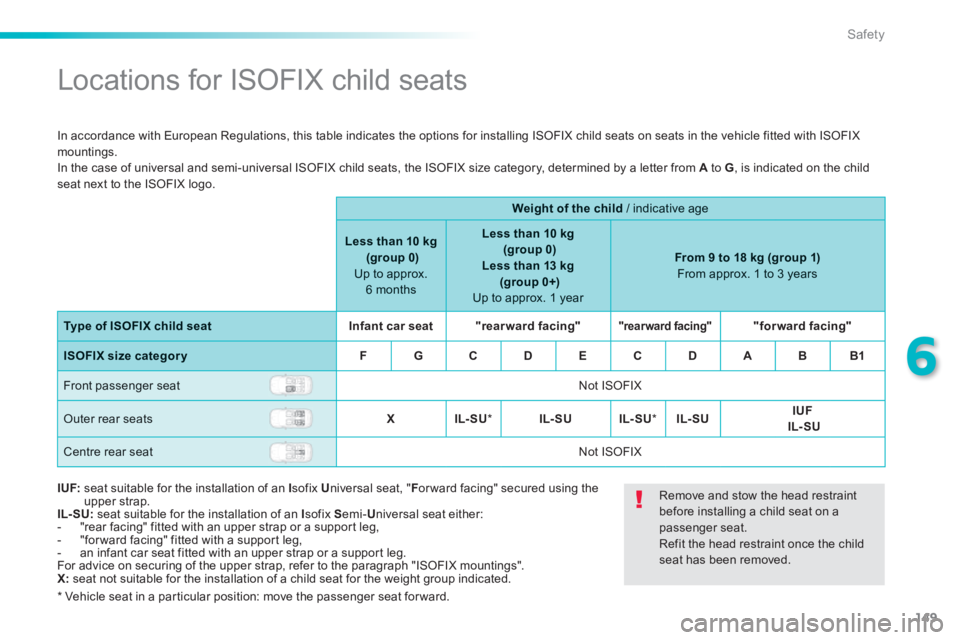2013.5 PEUGEOT 2008 remove seats
[x] Cancel search: remove seatsPage 22 of 336

20
Limit the causes of excess consumption
Spread loads throughout the vehicle; place the heaviest items in the bottom of the boot, as close as possible to the rear seats. Limit the loads carried in the vehicle and reduce wind resistance (roof bars, roof rack, bicycle carrier, trailer...). Use a roof box in preference. Remove roof bars and roof racks after use.
At the end of winter, remove snow tyres and refit your summer tyres.
Observe the recommendations on
maintenance
Check the tyre pressures regularly, when cold, referring to the label in the door aperture, driver's side. Carry out this check in particular: - before a long journey, - at each change of season, - after a long period out of use. Don't forget the spare wheel and the tyres on any trailer or caravan.
Have your vehicle serviced regularly (engine oil, oil filter, air filter, passenger compartment filter...) and observe the schedule of operations recommended in the warranty and maintenance record.
When refuelling, do not continue after the third cut-off of the nozzle to avoid any over flow.
At the wheel of your new vehicle, it is only after the first 1 800 miles (3 000 kilometres) that you will see the fuel consumption settle down to a consistent average.
Page 79 of 336

77
3
Comfort
Never use the ISOFIX ring intended for fixing the upper strap of child seat to the Top Tether.
To use it in row 1: open the covers of the upper fixings 1 , unroll the high load retaining net, position one of the ends of the net's metal bar in the corresponding upper fixing 1 , then do the same with the other end, slacken the straps fully, fix the snap hook of each of the straps on the corresponding lug 3 , located under the bench seat cushion, fold the rear seats, tighten the straps without raising the
bench seat, check that the net is hooked and tightened c o r r e c t l y.
To use it in row 2: fold or remove the load space cover, open the covers of the upper fixings 2 , unroll the high load retaining net, position one of the ends of the net's metal bar in the corresponding upper fixing 2 , then do the same with the other end, attach the hook of each of the net's straps in the corresponding lower ring 4 , tighten the straps, check that the net is hooked and tightened c o r r e c t l y.
Page 138 of 336

136
Safety
Sit in a normal upright position. Wear a correctly adjusted seat belt. Do not leave anything between the occupants and the airbags (a child, pet, object...). This could hamper the operation of
the airbags or injure the occupants. After an accident or if the vehicle has been stolen or broken into, have the airbag systems checked. All work on the airbag system must be carried out by a PEUGEOT dealer or a qualified workshop. Even if all of the precautions mentioned are observed, a risk of injury or of minor burns to the head, chest or arms when an airbag is deployed cannot be ruled out. The bag inflates almost instantly (within a few milliseconds) then deflates within the same time discharging the hot gas via openings provided for this purpose.
Lateral airbags
Use only approved covers on the seats, compatible with the deployment the lateral airbags. For information on the range of seat covers suitable for your vehicle, you can contact a PEUGEOT dealer. Refer to the "Accessories" section. Do not fix or attach anything to the seat backs (clothing...). This could cause injury to the chest or arms if the lateral airbag is deployed. Do not sit with the upper part of the body any nearer to the door than necessary.
Front airbags
Do not drive holding the steering wheel by its spokes or resting your hands on the centre part of the wheel. Passengers must not place their feet on the dashboard. If possible, do not smoke as deployment of the airbags can cause burns or the risk of injury from a cigarette or pipe. Never remove or pierce the steering wheel or hit it violently.
For the airbags to be fully effective, observe the following safety rules:
Curtain airbags
Do not fix or attach anything to the roof. This could cause injury to the head if the curtain airbag is deployed. If fitted on your vehicle, do not remove the grab handles installed on the roof, they play a part in securing the curtain airbags.
Page 146 of 336

144
Safety
(a) Universal child seat: child seat which can be installed in all vehicles using the seat belt. (b) Group 0: from birth to 10 kg. Infant car seats and "car cots" cannot be installed on the front passenger seat. (c) Consult the legislation in force in your country before installing your child on this seat. (d) To install a child seat on a rear seat, "rear ward facing" or "for ward facing", move the front seat for ward, then straighten the backrest to allow enough space for the child seat and the child's legs. U : seat suitable for the installation of a child seat secured using the seat belt and universally approved "rearward facing" and/or "forward facing". U(R) : as for U , the vehicle seat must be adjusted to the highest position and the intermediate longitudinal position. X : seating position not suitable for the installation of a child seat of the weight group indicated.
Remove and stow the head restraint before installing a child seat on a passenger seat. Refit the head restraint once the child seat has been removed.
Page 147 of 336

145
6
Safety
The incorrect installation of a child seat in a vehicle compromises the child's protection in the event of an accident. Ensure that there is no seat belt or seat belt buckle under the child seat, as this could destabilise it. Remember to fasten the seat belts or the child seat harnesses keeping the slack relative to the child's body to a minimum, even for short journeys. When installing a child seat using the seat belt, ensure that the seat belt is tightened correctly on the child seat and that it secures the child seat firmly on the seat of your vehicle. If your passenger seat is adjustable, move it for wards if necessary. At rear seating positions, always leave sufficient space between the front seat and: - a "rear ward facing" child seat,
- the child's feet for a child seat fitted "forward facing". To do this, move the front seat for wards and, if necessary, move its backrest into the upright position.
Advice on child seats
Installing a booster seat For optimum installation of the "forward-facing" child seat, ensure that the back of the child seat is as close as possible to the backrest of the vehicle's seat , in contact if possible. You mst remove the head restraint before installing a child seat with backrest to a passenger seat. Ensure that the head restraint is stored or attached securely to prevent it from being thrown around the vehicle in the event of sharp braking. Refit the head restraint when the child seat is removed.
Children at the front
The legislation on carrying children on the front passenger seat is specific to each country. Refer to the legislation in force in your country. Deactivate the passenger airbag when a "rear ward-facing" child seat is installed on the front seat. Otherwise, the child would risk being seriously injured or killed if the airbag were to inflate.
The chest part of the seat belt must be positioned on the child's shoulder without touching the neck. Ensure that the lap part of the seat belt passes correctly over the child's thighs. PEUGEOT recommends the use of a booster seat which has a back, fitted with a seat belt guide at shoulder level. As a safety precaution, do not leave: - a child or children alone and unsupervised in a vehicle, - a child or an animal in a vehicle which is exposed to the sun, with the windows closed, - the keys within reach of children inside the vehicle.
To prevent accidental opening of the doors and rear windows, use the "Child lock". Take care not to open the rear windows by more than one third. To protect young children from the rays of the sun, fit side blinds on the rear windows.
Page 148 of 336

146
Safety
Your vehicle has been approved in accordance with the latest ISOFIX regulation . The seats, represented below, are fitted with regulation ISOFIX mountings:
"ISOFIX" mountings
There are three rings for each seat: - two rings A , located between the vehicle seat back and cushion, indicated by a marking,
When fitting an ISOFIX child seat to the left hand rear seat, before fitting the seat, first move the centre rear seat belt towards the middle of the vehicle, so as to avoid the seat inter fering with the operation of the seat belt.
Follow the instructions for fitting child seats contained in the seat manufacturer's installation guide.
For information on the possibilities for installing ISOFIX child seats in your vehicle, refer to the summary table.
- a ring B behind the seat for fixing the upper strap, referred to as the Top Tether . Top Tether . Top Tether
The top tether is used to secure the upper strap of child seats that have one. This arrangement limits the for ward tipping of the child seat in the event of a front impact. This ISOFIX mounting system provides fast,
reliable and safe fitting of the child seat in your vehicle.
To secure the child seat to the top tether : - remove and stow the head restraint before installing the child seat in this seating position (refit it once the child seat has been removed), - pass the strap of the child seat over the top of the seat backrest, centred between the apertures for the head restraint rods, - fix the hook of the upper strap to the ring B , - tighten the upper strap.
The incorrect installation of a child seat in a vehicle compromises the child's protection in the event of an accident.
The ISOFIX child seats are fitted with two latches which are secured on the two rings A . Some seats also have an upper strap , known as the Top Tether, which is attached to ring B .
Page 151 of 336

149
6
Safety
Locations for ISOFIX child seats
In accordance with European Regulations, this table indicates the options for installing ISOFIX child seats on seats in the vehicle fitted with ISOFIX mountings. In the case of universal and semi-universal ISOFIX child seats, the ISOFIX size category, determined by a letter from A to G , is indicated on the child seat next to the ISOFIX logo.
Weight of the child / indicative age
Less than 10 kg (group 0) Up to approx. 6 months
Less than 10 kg (group 0) Less than 13 kg (group 0+) Up to approx. 1 year
From 9 to 18 kg (group 1) From approx. 1 to 3 years
Type of ISOFIX child seatInfant car seat"rearward facing""rearward facing""forward facing"
ISOFIX size categor yFGCDECDABB1
Front passenger seat Not ISOFIX
Outer rear seats XIL- SU * IL- SUIL- SU * IL- SUIUF IL- SU
Centre rear seat Not ISOFIX
I UF: seat suitable for the installation of an I sofix U niversal seat, " F or ward facing" secured using the upper strap. IL- SU: seat suitable for the installation of an I sofix S emi- U niversal seat either: - "rear facing" fitted with an upper strap or a support leg, - "for ward facing" fitted with a support leg, - an infant car seat fitted with an upper strap or a support leg. For advice on securing of the upper strap, refer to the paragraph "ISOFIX mountings". X: seat not suitable for the installation of a child seat for the weight group indicated.
* Vehicle seat in a particular position: move the passenger seat for ward.
Remove and stow the head restraint before installing a child seat on a passenger seat. Refit the head restraint once the child seat has been removed.